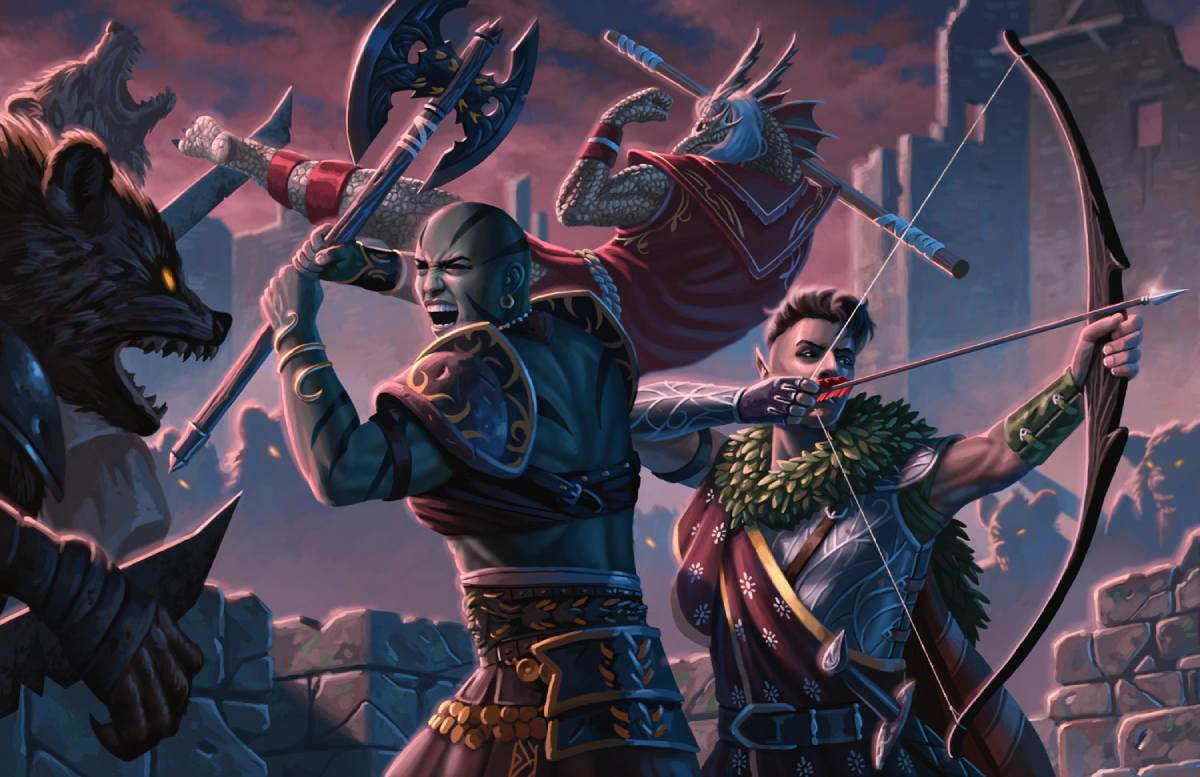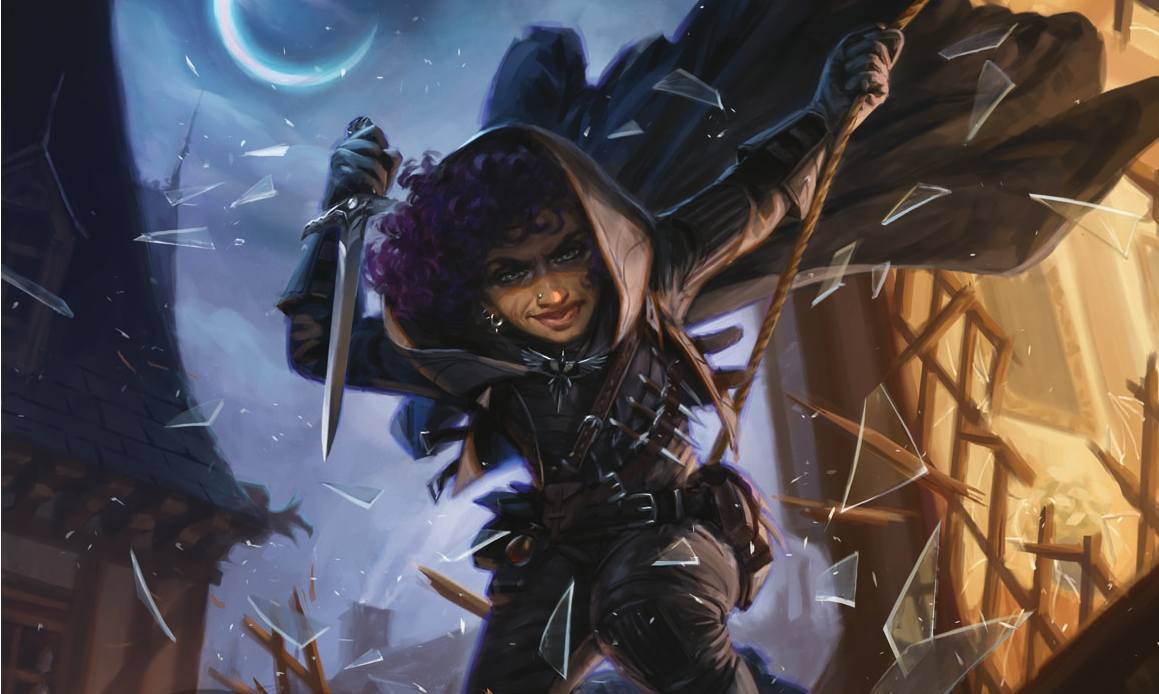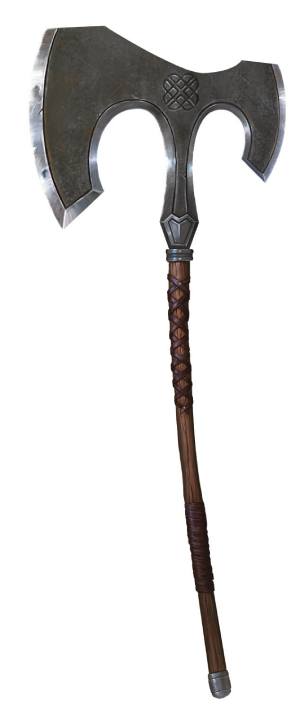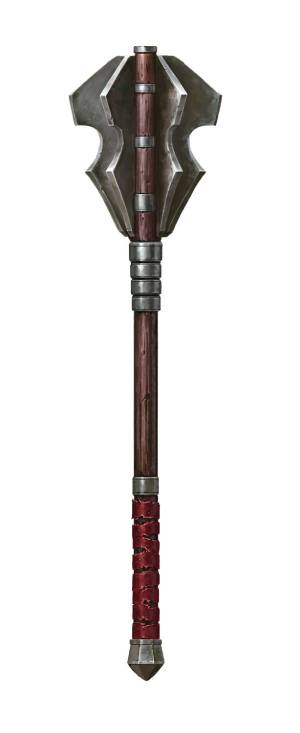The Fighter uses their Maul to knock down their opponent, the Rogue dances around with their Rapier to find their foe’s weak point, and the Barbarian swings a Greataxe through two enemies with a single blow. Every character in D&D has a unique flare they bring to combat, and that’s reflected in the new Weapon Mastery feature in the Player’s Handbook!
Let’s explore these fresh ways to utilize your weapons in the upcoming core rulebook revamp!
Build Your Warrior Today
Start building your weapon-wielding warrior today in D&D Beyond's Character Builder. You can access Weapon Mastery for free using the D&D Beyond Basic Rules, so you can test out this new brand-new system and start cutting a heroic path through your foes!
What is Weapon Mastery?

Weapon Mastery is a class feature shared between some martial classes that reflects their specialization with certain types of weapons.
Each weapon in the Equipment section of the 2024 Player’s Handbook lists a mastery property in addition to the weapon’s regular properties. If the weapon meets the requirements in your class's Weapon Mastery feature, you can learn its mastery property and use it in combat.
But learning a mastery property isn't permanent. If you stumble across a shiny new +1 Longsword and want to learn its mastery properties instead, don’t worry! During a Long Rest, you can practice weapon drills and swap out one of your weapon choices at the end of the rest.
The number of mastery properties you can learn is specified in your class's version of the Weapon Mastery feature. Rogues, rangers, and paladins can only access two mastery properties at a time, whereas barbarians and fighters start with two and three, respectively, and eventually gain access to more mastery properties, as detailed in their Features table.
At level 1, Barbarians, Fighters, Paladins, Rangers, and Rogues get access to the mastery properties for certain types of weapons, as listed below:
- Barbarian: Simple and Martial Melee weapons
- Fighter: Simple and Martial weapons
- Paladin: Based on weapon proficiencies (Simple and Martial weapons)
- Ranger: Based on weapon proficiencies (Simple and Martial weapons)
- Rogue: Based on weapon proficiencies (Simple weapons and Martial weapons with the Finesse or Light property)
Mastering Weapon Mastery
Some subclasses allow you to access more mastery properties. For example, the Soulknife Rogue can use the Vex mastery property with their Psychic Blades and it doesn’t count toward their learned Weapon Mastery limit.
How to Use Weapon Mastery Properties
If you’re wielding a weapon and have learned its mastery property, you’ll be able to use that mastery property every turn when you make an attack with the weapon.
Different mastery properties have different triggers. For example, Cleave requires you to hit a creature with a melee attack roll while Graze triggers when you miss a creature with an attack roll.
Unlike some abilities, there’s no limit to how many times mastery properties can be used per Short or Long Rest, so go nuts!
Mastery Properties Overview

Below, we’ll cover each of the eight mastery properties included in the 2024 Player’s Handbook. We’ll even throw in some tips to help you brainstorm ideas for your new characters!
Cleave

Example Weapon: Greataxe
If you’ll be wading into the thick of battle, you’ll want to consider grabbing a weapon with the Cleave property.
These heavy weapons can slash through opponents. If you hit a creature with a melee weapon attack, you can make a second attack against a creature within 5 feet that is also within your reach. When you hit with the second attack, you can roll your weapon’s damage, but you don’t add your ability modifier unless it’s negative.
This is excellent in combination with the Halberd, which has Reach and Cleave, allowing you to Cleave into enemies in an extended range.
Graze
Example Weapon: Greatsword
Graze is an excellent way to increase the consistency of your weapon damage.
If you miss a creature with your weapon, you deal damage equal to the ability modifier you used to make the roll. This pairs well with abilities that allow you to make a lot of attacks, like the Fighter’s Extra Attacks features or the Polearm Master or Sentinel feats.
It just goes to show that when a weapon is big enough, you don't really need to aim where you're swinging.
Nick
Example Weapon: Dagger
To explain the Nick property, we should briefly cover that being able to attack twice while dual-wielding Light weapons has subtly changed in the 2024 Player’s Handbook. Instead of being covered under Melee Attacks, the rules for dual-wielding Light weapons are covered under the Light weapon property.
It still functions the same way: When you make an attack with a weapon that has the Light property, you can use a Bonus Action to make one attack with a different Light weapon you’re wielding.
The Nick mastery property allows you to make the additional attack you receive from wielding two Light weapons as part of the initial attack action.
Keep in mind that this doesn’t mean you can make a third attack as a Bonus Action, as the Light property specifies you only get one extra attack. But, while it may not pump your damage, this frees up your Bonus Action to use class/species abilities, such as the Rogue’s Cunning Action, while still getting an additional attack in.
Push
Example Weapon: Greatclub
Sometimes giving an enemy a simple shove off a cliff or into a pit of lava is all you need to win an otherwise tough encounter! The Push mastery property allows you to launch a creature you hit 10 feet straight away from you without a save.
Not only is this great when combined with environmental hazards, it's also great for escaping Opportunity Attacks. If you or a less tanky party member are being harassed by an enemy, you can push the enemy 10 feet away, which can allow you to create the space needed to escape unscathed.
Keep in mind that you can only push enemies Large or smaller, so don’t go getting stuck next to an Adult Black Dragon.
Sap

Example Weapon: Mace
If your job is to distract the enemies for long enough to let your blaster caster friends deal with them, Sap is a solid choice.
When you hit an enemy with an attack, this mastery property inflicts Disadvantage on your target’s next attack roll before the start of your next turn.
So, for heavily armored, tanky builds, your enemies will be so focused on trying to take you out that they won’t even see the Fireball coming.
Slow
Example Weapon: Light Crossbow
This mastery property is excellent for fast builds that like to flit across the battlefield. When you hit a creature and deal damage, you can reduce its Speed by 10 feet until the start of your next turn.
This combos excellently with the Light Crossbow, allowing you to take shots, damage your opponents, and then move to just out of range of their reduced Speed. Rinse and repeat until they look like a pin cushion.
It’s important to note that a creature hit more than once by weapons with this property doesn't have its Speed reduced any more than 10 feet. So don’t expect to stand still, hit your enemy three times, and not get caught.
Topple
Example Weapon: Maul
This mastery property is for all those builds that love to wail on their enemies with multiple melee attacks.
When you hit a creature, you can force it to make a Constitution saving throw or fall Prone. The DC for this save is 8 plus the ability modifier used to make the attack plus your Proficiency Bonus.
So, a level 5 Fighter with a Maul could knock their opponent Prone with their first attack, then use their second attack and Action Surge to make multiple attacks with Advantage.
Just remember attacking Prone enemies outside of 5 feet actually gives the attacker Disadvantage on their attack roll. So only use this ability if you or another melee-minded party member can take advantage of it.
Vex
Example Weapon: Shortsword
Having a weapon with Vex feels like a superior swordsman dancing around their opponent, striking at openings until the battle is won.
When you hit a creature and deal damage, this mastery property gives you Advantage on your next attack roll before the end of your next turn. This is an excellent way for Rogues to all but guarantee a Sneak Attack hit on their next turn.
The Student Becomes the Master
The 2024 Player’s Handbook is now available on the D&D Beyond marketplace, which means it's time to set out on new adventures with fresh or familiar characters!
Weapon Mastery is a fun way to give martial characters more choice in combat. It also revamps the way weapons feel in D&D. The new options and revisions presented in this book are a result of a decade of lessons learned and adventures had. With updated rules and streamlined gameplay, it's never been easier to bring your stories to life.
We’re delighted to share with you the changes to fifth edition D&D that appear in the 2024 Player’s Handbook. Make sure to keep an eye out on D&D Beyond for more useful guides on using the wealth of new options, rules, and mechanics found in the 2024 Player's Handbook!

Mike Bernier (@arcane_eye) is the founder of Arcane Eye, a site focused on providing useful tips and tricks to all those involved in the world of D&D. Outside of writing for Arcane Eye, Mike spends most of his time playing games, hiking with his partner, and tending the veritable jungle of houseplants that have invaded his house.
This article was updated on August 12, 2024, to issue corrections or expand coverage for the following features:
- What is Weapon Mastery?: Made clear that the Rogue is proficient with all Simple weapons.
- Slow: Clarified that the Slow property doesn't stack with itself.








-
View User Profile
-
Send Message
Posted Aug 23, 2024Agreed 👍
-
View User Profile
-
Send Message
Posted Aug 23, 2024people are complaining that monk doesnt have access to weapon masteries
1 level in fighter gets you access to fighting style and weapon masteries plus second wind.
besides that access, there is only 1 monk subclass that USES weapons...why would they give the UNARMED subclass WEAPON MASTERIES.
-
View User Profile
-
Send Message
Posted Aug 23, 2024Shortsword and dagger makes sense. But shortsword and scimitar which is the mechanically better option feels weird. Dual weilding scimitars is out now. Personally I would let a player use a scimitar as if it were a shortsword (provided they also take shortsword mastery) but that will be a houserule. It would be cool if every weapon had a second mastery, you would need to use a second mastery on it but then unlock the second mastery, make it so you cannot use both on a single attack.
-
View User Profile
-
Send Message
Posted Aug 23, 2024I think people are missing the fact that unarmed strikes now have several things Monks can use that are like weapon masteries but just aren't called that because they're not, you know, weapons
-
View User Profile
-
Send Message
Posted Aug 23, 2024I believe ( I could be wrong) but the UA high level fighter would let you do just that. Swap Vex for Nick on a scimitar. I don't think other classes can do that, though.
-
View User Profile
-
Send Message
Posted Aug 25, 2024What about Weapon Mastery for Unarmed Strikes, since Unarmed Fighting is a Fighting Style?
-
View User Profile
-
Send Message
Posted Aug 25, 2024The text in the UA specifies "Mastery Weapons" so probably RAI and RAW no for unarmed strikes. I would allow it homebrew in my games. I like more than just monks being able to fight effectively unarmed.
-
View User Profile
-
Send Message
Posted Aug 25, 2024Could anybody tell me what the new blaster weapon is and what it’s supposed to look like so that I can flavor it correctly🙏🙏🙏
-
View User Profile
-
Send Message
Posted Aug 28, 2024You want to shove the adult black dragon, dont you.
-
View User Profile
-
Send Message
Posted Aug 30, 2024Why is nick so bad?
-
View User Profile
-
Send Message
Posted Sep 3, 2024its reminiscent of Pathfinder 2e.. which has had a rule like this 5 years ago...
-
View User Profile
-
Send Message
Posted Sep 3, 2024For the nick property , is needed to be applied to the weapon you attack with first , second, or both? For example if you have a short sword and a dagger and you have mastery with the dagger can you still use the nick property even though one of those weapons doesn’t have it
-
View User Profile
-
Send Message
Posted Sep 3, 2024Rip Bloodhunters, they didn't have studied the patch note XD
-
View User Profile
-
Send Message
Posted Sep 5, 2024So as Vex reads. I can hit with an attack, gain advantage, then off-hand attack with advantage to gain vex again assuming my off-hand hits? Then just perpetually give myself advantage?
-
View User Profile
-
Send Message
Posted Sep 5, 2024rules as written yes but considering its dumb your dm will probably be willing to ignore it
-
View User Profile
-
Send Message
Posted Sep 9, 2024Does cleave trigger every successful hit? Or only once per turn? If the former, a level 20 fighter could hit enemyA 4 times, and cleave EnemyB 4 times?
-
View User Profile
-
Send Message
Posted Sep 10, 2024I have a 5e fighter with Unarmed Fighting as my Fighting Style. Is it true that unarmed strikes don’t get any benefits of Weapon Mastery? If so, is my unarmed fighter objectively bad, since he can’t take advantage of this new buff?
-
View User Profile
-
Send Message
Posted Sep 11, 2024Not the biggest fan of Weapons Mastery, but there is a solid list of all the 2024 DnD Weapons here (including their Mastery Properties) and a deeper dive into how the rules work (i.e. Simple vs Martial): https://dungeonsanddragonsfan.com/dnd-weapons-rules/
-
View User Profile
-
Send Message
Posted Sep 12, 2024For both balance and keeping the game moving, this seems pretty overpowered. Giving a reason to select certain weapons is fine, but it feels like these uses should really be limited by short rests or proficiency bonus or something. A lot of weapons also just seem randomly sorted into one effect, when multiple would make sense for them.
-
View User Profile
-
Send Message
Posted Sep 18, 2024That was realy goog explained!👻